CSET English Subtest I
Reading Literature and Informational Texts
This domain consists of 40 multiple-choice questions within 6 competencies:
- Reading Literature
- Craft and Structure of Literature
- Reading Informational Texts
- Craft and Structure of Informational Texts
- Integration of Knowledge and Ideas in Informational Texts
- Text Complexity
Reading Literature
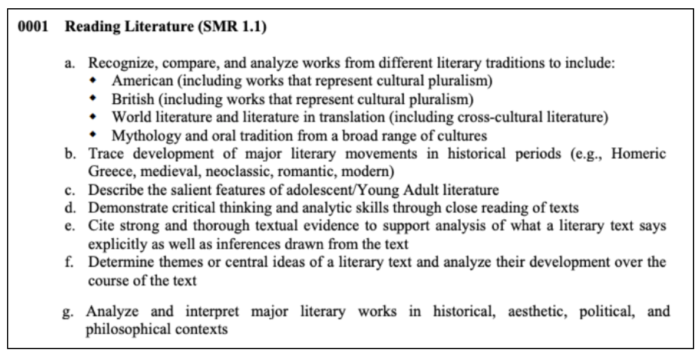
This section tests your knowledge of different literary traditions.
Let’s talk about a concept that you will more than likely see on the test.
Features of Young Adult Literature
- Point of view of a protagonist teenager (ex. The Outsiders)
- Dialogue is usually blunt and can be confrontational (ex. Perks of Being a Wallflower)
- Story development is usually over a short period of time (freshman year, summer vacation, spring break)
- Parents are usually absent or have conflicts with the young adults (ex. The Fault in Our Stars)
- Endings are not always happy (ex. A Formal Feeling)
- Coming of age issues (ex. Chocolate War)
Craft and Structure of Literature

This section tests your knowledge of the elements and organization of literature.
Let’s talk about a concept that you will likely see on the test.
Basic Elements of Literature
- Plot refers to the sequential events used to show development in a story. Stories sometimes progress through many different plots. Dramas are divided into acts and scenes. Playwrights use dialogue to develop their plots.
- Setting refers to when and where the story takes place. Settings can be smaller in scale, like a park or forest; or they can be large and encompassing, like an era or historical time period. The characters in the story can also describe the setting and give the reader an interpretation and view of where it is taking place.
- Characters refer to who the story is about. They give readers something in which to invest. Characters can be people, animals, or creatures.
- Point of view refers to who is telling the story. The first person uses words like “I” and “me.” The narrator is part of the story. You only read the thoughts, feelings, and opinions of the person telling the story. The second person uses “you” and is rarely used in fiction. The third person uses words like “he”, “she”, and characters’ names. Third person point of view allows the expression of thoughts, feelings, and opinions of multiple characters.
- The theme refers to the big idea of the story. Examples of common themes include betrayal, loyalty, friendship, love, justice, and hypocrisy.
- Narrative structure refers to the content of the story and the structure that is used to tell the story. The common narrative structure has three parts. It starts with the exposition, or beginning leads into the rising action, climax, and falling action. It ends with the resolution or denouement. However, narratives may take other forms depending on the genre.
- Figurative language refers to figures of speech in the literature that increase effectiveness and impactfulness of the author’s message. Common literary devices include similes, metaphors, personification, oxymorons, hyperbole, and idioms.
- Tone refers to the point of view or attitude the author takes in the story. Tone comes in many forms depending on the author’s feelings. It can be humorous, arrogant, solemn, joyful, sad.
- Diction is word choice. It is an element of drama that advances the plot. Formal, informal, colloquial, and slang diction are used in different contexts and settings in literature. Writers use diction to set a specific mood, tone, or atmosphere for the reader.
- Style refers to how the author chooses words and organization to tell a story. Four main types of writing styles are expository, descriptive, persuasive, and creative writing.
Reading Informational Texts
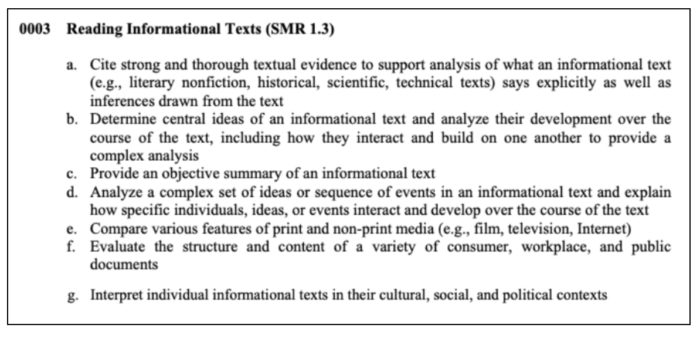
This section tests your knowledge of the analysis of informational texts.
Let’s talk about a concept that you will likely see on the test.
Summaries of Informational Text
When writing an objective summary of an informational text, you should focus on the central idea and include the title and author of the text. You should provide the most important information and omit supporting or minor details. Do not include any opinions or personal feelings on the information. The information should not be copied but rewritten in your own words. It should not be written in the first person.
Example of an Objective Summary:
Moose
by Christy Mihaly provides important information of a moose’s development. The text explains what regions moose live in and how their bodies are made to adapt to their environments. It explains the changes of their antlers and how they use them to find a mate. The text begins with information on the beginning of a moose’s life and follows it throughout its lifecycle.
Craft and Structure of Informational Texts
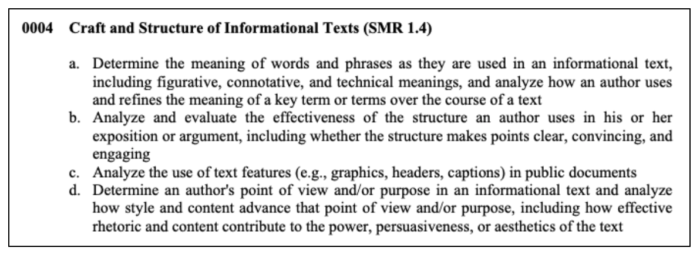
This section tests your knowledge of the features and structure of informational texts.
Let’s look at a concept that is likely to pop up on the test.
Text Features
Authors use text features to help the reader navigate through the text easier. Examples include:
- Graphics– visual ways to present information from the text to give the reader a better understanding of the information
- Headers– break the text into sections and make it easier to find information
- Captions– words located directly above, beside, or below a picture that provide specific information
- Table of Contents– outlines important parts of the text and guides the reader to find that information more easily by providing page numbers
- Glossary– usually located in the back of the text and defines bolded words found in the text
- Bold Print– used to show that something is important in the text and can be found in the glossary
Integration of Knowledge and Ideas in Informational Texts

This section tests your knowledge of using different media or formats to evaluate historical documents and use legal reasoning to defend an argument.
Here is a concept that is likely to be part of the test.
The Constitution of the United States
The purpose of the US Constitution is to create a government based on a checks and balances system that protects the rights of its citizens. The major themes of the US Constitution are limited government, checks and balances, separation of powers, popular sovereignty, federalism, and judicial review. The rhetorical features found in the US Constitution are repetition and parallelism.
Text Complexity

This section tests your understanding of the structure and language in a text to determine grade-level appropriateness.
Here is a concept you definitely need to know.
Qualitative Dimensions of Text Complexity
- Levels of meaning can change the complexity of the text. If there is one meaning, like in an informational text, it is easier to understand. If there are hidden meanings, it can make the text more complex.
- Structure can change the complexity of the text. If the plot is in sequential order, it is easier to follow. If there are flashbacks or changes in time, the complexity of the text changes. It becomes harder to follow.
- Language conventionality and clarity refer to the examination of the language in the text. When there are words with multiple meanings, it makes the text more complex.
- Background knowledge demands refer to the level of background knowledge the reader needs in order to understand the text.
Composition and Rhetoric
This domain consists of 10 multiple-choice questions within 5 competencies:
- Writing Processes
- Text Types and Purposes
- Production and Distribution of Writing
- Conventions of Oral and Written Language
- Research to Build and Present Knowledge
Writing Processes

This section tests your knowledge of the structure of the writing process.
Let’s talk about a concept that you will more than likely see on the test.
Revising
Revising is the stage in the writing process where the author revisits their writing to reread and change what they have written. Revising never stops and continues throughout the writing process. It can occur at any time in the writing process. Revising entails many aspects from changing the structure of the writing, rewording sentences, fixing grammatical errors, or even deleting entire paragraphs.
Text Types and Purposes
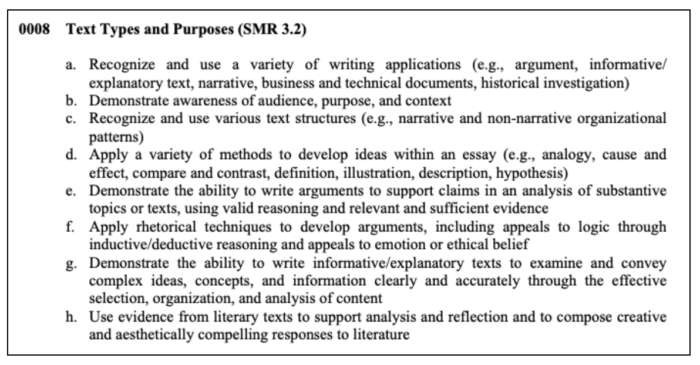
This section tests your knowledge of the ability to recognize, apply, and demonstrate multiple types of text structures and their purpose of how they contribute to the text.
Here are some concepts you definitely need to know.
Non-Narrative Text Structures
In non-narrative text structures, the text might not be in chronological order but can be organized in a variety of ways. Text structures can be identified by certain signal words that are specific to each structure.
- Problem/Solution has a problem that needs to be solved and lists one or more ways the problem can be solved.
- Cause and Effect tell the reader the result of an event and the reasons it happened.
- Compare/Contrast texts look at the similarities and differences of two or more topics, events, objects, or ideas.
- Description/List is set up like an outline used to elaborate on a specific topic or main idea.
- Time Order/Sequence uses transitional words to structure the events or steps in order.
Production and Distribution of Writing
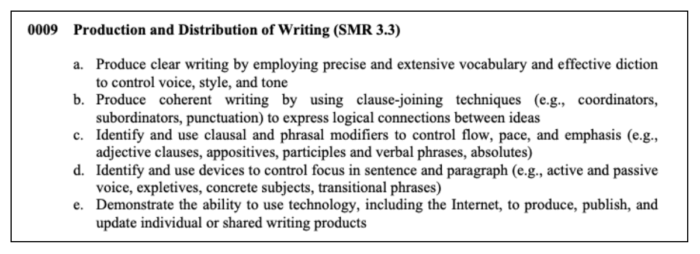
This section tests your knowledge of ways to use proper writing techniques to produce and share writing products.
Here is a concept that is likely to be part of the test.
Appositives
Appositives rename a noun by using a different noun or noun phrase to redefine it. The purpose of an appositive is to give the sentence more detail and elaborate on the noun being described.
Examples:
My sister’s car, a white sedan, was stolen yesterday.
The appositive is a white sedan and car is the noun it describes.
My mother Jill loves to cook.
The appositive is Jill and mother is the noun it describes.
Conventions of Oral and Written Language
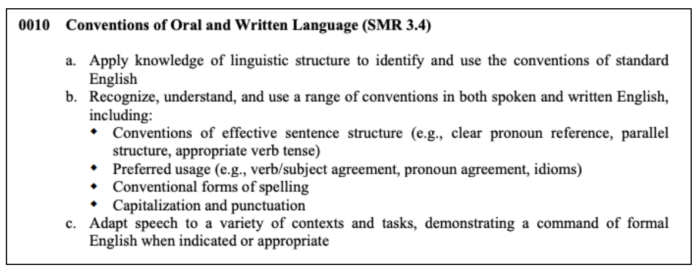
This section tests your knowledge of how to use writing conventions and structures correctly in written English.
Here is a concept you definitely need to know.
Parallel Structure
Parallel structure is where you repeat the same grammatical form within a sentence. It is sometimes referred to as parallelism.
Example:
NOT parallel:
My friend likes to go swimming, hike and take naps.
Parallel:
My friend likes swimming, hiking, and napping.
When the sentence uses parallel structure each verb stays in the same grammatical form of present tense.
Research to Build and Present Knowledge

This section tests your knowledge of demonstrating, gathering, and interpreting research findings to integrate information into written text.
Here are some concepts you definitely need to know.
Footnotes and Endnotes
Footnotes and endnotes are used to cite or give attribution to someone else’s information used in the text. Footnotes are used for a short citation and are located at the bottom of the page it is citing. Endnotes are located at the end of a large section or at the end of the document. Endnotes do not take away from the text on the page and can contain more in-depth information due to their location.
And that is some basic information about Subtest I of the CSET English exam.
